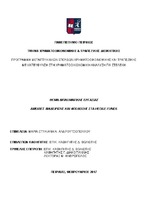Αμοιβές διαχείρισης και απόδοσης στα hedge funds

View/
Keywords
Ηθικός κίνδυνος ; Κεφάλαιο αντιστάθμισης κινδύνου ; Αμοιβή διαχείρισης ; Αμοιβή κινήτρου ; Ελάχιστο επίπεδο απόδοσης ; Hedge funds ; Management fee ; Moral hazard ; Incentive fee ; High water mark ; Principal-agent gameAbstract
Hedge funds industry has grown significantly in recent years, resulting in an object of interest
for the entire financial system. It is difficult to assess accurately the actual size of the hedge
funds industry, given that the SEC imposes restrictions on advertising for hedge funds. However,
it is estimated that hedge funds have increased from $ 39 million in 1990 to approximately $ 972
million in 2004. During this period, the total number of hedge funds has grown from 610 in 1990
to 7,436 in 2004. In addition, the distribution between different strategies of hedge funds has
also changed significantly during the same period.
Although hedge funds have gained popularity in recent years with the rise of the managers of
hedge funds, such as George Soros and Julian Robertson, have existed for many years. In fact,
there is no universally accepted definition of hedge funds. Given the huge growth of this industry
and the limited information available on hedge funds, an urgent need for further analysis of the
different forms of compensation managers, and the problem of representation involved.
Investors must investigate thoroughly, to be able to know what to invest and in which risks are
exposed.
So, in this paper, we try to summarize an overview of academic research on performance and
management fees of hedge funds to assess whether incentives appear distortion problems such
as moral hazard. Our goal is to design an optimal contract, which will protect the interests of the
investor, but it will be tempting for the manager, without compromising the interests of principal.


